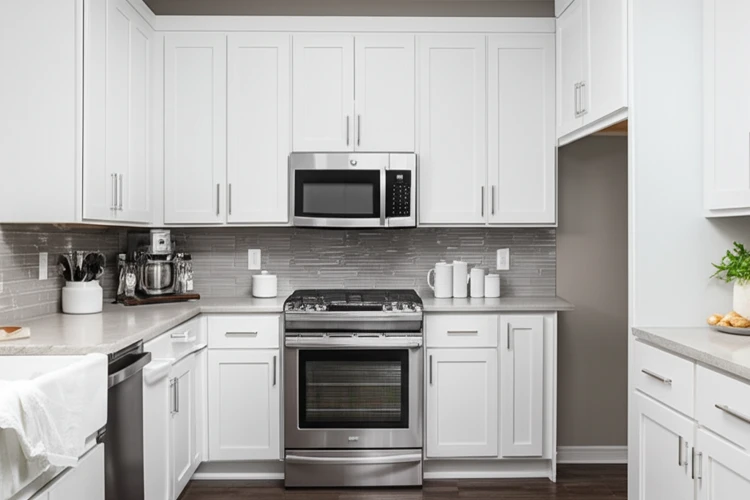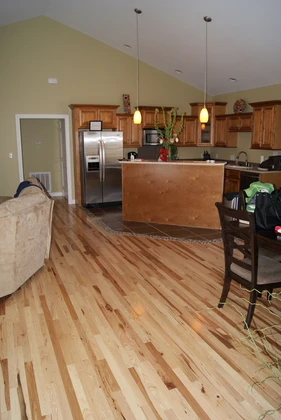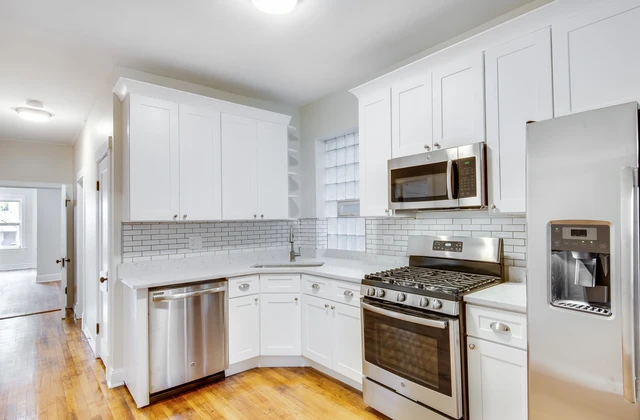Disclaimer: As an Amazon Associate, I earn commission from qualifying purchases.
The combination of white kitchen cabinets and grey floors has become a staple in modern kitchen design, and for good reason. This pairing creates a visual harmony that is both aesthetically pleasing and versatile. The clean, crisp look of white cabinets paired with the neutral tones of grey floors can transform any kitchen into a space that feels fresh, clean, and inviting.
From an interior design perspective, the use of white and grey is rooted in color theory. White represents purity, cleanliness, and simplicity, while grey adds a sophisticated and balanced touch. This color scheme is not only timeless but also adaptable to various styles, whether traditional, contemporary, or transitional.
Real homeowners who have implemented this design have reported feeling more satisfied with their kitchen’s overall appearance. The neutral palette allows for easy integration of other design elements, such as colorful accents or bold patterns, without overwhelming the space. For example, a homeowner might choose to add vibrant backsplash tiles or a brightly colored rug to inject personality into the room.
Practical Considerations for White Kitchen Cabinets
While white kitchen cabinets offer a stunning visual appeal, they also come with practical considerations that homeowners should be aware of. Understanding the pros and cons can help in making an informed decision.
Pros:
- Enhances the feeling of spaciousness: White cabinets reflect light, making even small kitchens feel more spacious and airy.
- Versatility: White cabinets can be paired with a variety of countertops, backsplashes, and flooring options, offering flexibility in design.
- Easy to clean: Modern white cabinet finishes are often easy to clean, requiring only mild soap and water.
Cons:
- Shows dirt and stains: White cabinets can be more prone to showing dirt, stains, and fingerprints, which may require more frequent cleaning.
- Durability concerns: Some types of white paint or finishes may be less durable and more susceptible to scratches or chipping.
- Cost: High-quality white cabinets can be more expensive than other color options due to the need for multiple coats of paint.
Professional experience in kitchen design suggests that while white cabinets may require more maintenance, their aesthetic and functional benefits often outweigh the drawbacks. Industry publications highlight the importance of choosing durable materials and finishes to mitigate some of these concerns.
Choosing the Right Grey Floors for Your Kitchen
Selecting the right grey flooring for your kitchen is crucial for both aesthetics and functionality. Different types of grey flooring options offer varying benefits and drawbacks.
Tiles: Grey tiles are a popular choice for kitchens due to their durability and easy maintenance. They are resistant to water, stains, and scratches, making them ideal for high-traffic areas. However, they can be cold underfoot and may require additional heating solutions.
Hardwood: Grey hardwood floors add a touch of warmth and natural beauty to the kitchen. They are durable and can be refinished if damaged. However, hardwood floors can be more expensive and may require more maintenance, especially in areas prone to moisture.
Laminate: Grey laminate flooring is a cost-effective and low-maintenance option. It mimics the look of hardwood or tile but is more resistant to scratches and moisture. However, it may not be as durable as natural materials in the long run.
Flooring industry guides recommend considering factors such as budget, maintenance requirements, and the overall style of the kitchen when choosing grey flooring. Transparent pricing information can help homeowners make informed decisions based on their specific needs and preferences.
Design Tips for Integrating White Cabinets and Grey Floors
Integrating white kitchen cabinets with grey floors requires careful planning to achieve a cohesive and stylish look. Here are some actionable design tips:
Color Schemes: Opt for a monochromatic color scheme by adding grey accents to the walls, countertops, or backsplash. This creates a seamless and harmonious look. Alternatively, introduce pops of color through accessories, such as colorful bar stools or decorative items.
Lighting: Proper lighting is essential to enhance the brightness of white cabinets and the sophistication of grey floors. Consider a combination of ambient, task, and accent lighting to create a well-lit and inviting space.
Accessories: Incorporate metallic accents, such as brass or chrome hardware, to add a touch of elegance. Textured rugs, decorative trays, and stylish kitchen appliances can also complement the overall design.
Design blogs and interior decorating books often highlight the importance of layering textures and colors to create depth and interest in the kitchen. Disclaimers about personal preferences and budget considerations should be kept in mind when implementing these design tips.
Optimizing Kitchen Efficiency with White Cabinets
Organizing white kitchen cabinets for maximum efficiency involves strategic planning and the right storage solutions. Here are step-by-step guidelines:
Step 1: Assess Your Needs: Determine what items you need to store and how frequently you use them. This will help you allocate space effectively.
Step 2: Use Organizers: Invest in cabinet organizers such as shelf liners, pull-out trays, and tiered racks to maximize space and keep items easily accessible.
Step 3: Group Similar Items: Organize items by category, such as baking supplies, cooking utensils, and cleaning products. This makes it easier to find what you need quickly.
Step 4: Label Everything: Use labels to identify the contents of each cabinet and drawer. This helps maintain order and ensures that items are returned to their designated spots.
Product recommendations for storage solutions include adjustable shelves, lazy Susans, and drawer dividers. Professional organizers suggest regularly reviewing and decluttering cabinets to maintain efficiency.
Sustainability in Kitchen Design with White Cabinets and Grey Floors
Incorporating sustainability into kitchen design with white cabinets and grey floors involves choosing eco-friendly materials and practices. Here are some examples:
Eco-Friendly Materials: Opt for cabinets made from sustainable materials such as bamboo or reclaimed wood. Choose low-VOC paints and finishes to reduce harmful emissions.
Energy-Efficient Appliances: Invest in energy-efficient kitchen appliances to reduce energy consumption and lower utility bills.
Sustainable Flooring: Select grey flooring options that are eco-friendly, such as cork or linoleum, which are renewable and biodegradable.
Environmental studies and sustainability guides emphasize the importance of considering the environmental impact of different materials. A balanced perspective on the sustainability of various options can help homeowners make informed decisions.
Maintenance Tips for White Kitchen Cabinets
Maintaining the cleanliness and longevity of white kitchen cabinets requires regular care and the right cleaning techniques. Here are some practical tips:
Step 1: Regular Cleaning: Wipe down cabinets regularly with a mild soap and water solution to remove dirt and stains. Avoid using harsh chemicals that can damage the finish.
Step 2: Protect from Moisture: Protect cabinets from excessive moisture by using cabinet liners and ensuring proper ventilation in the kitchen.
Step 3: Address Stains Promptly: Treat stains and spills immediately to prevent them from setting in and becoming more difficult to remove.
Cleaning industry publications recommend specific cleaning products and techniques for maintaining white cabinets. Transparent information on the effectiveness of different cleaning products can help homeowners choose the best options for their needs.
Maintenance Tips for Grey Kitchen Floors
Maintaining grey kitchen floors involves specific care techniques tailored to the type of flooring. Here are some guidelines:
Tiles: Clean tile floors with a mild detergent and water solution. Avoid using acidic or abrasive cleaners that can damage the surface. Regularly sweep or vacuum to remove dirt and debris.
Hardwood: Use a hardwood-specific cleaner and avoid excessive water exposure. Regularly sweep and use a damp mop to keep the floors clean and well-maintained.
Laminate: Clean laminate floors with a gentle cleaner and avoid using too much water. Regularly sweep and use a damp mop to maintain the floor’s appearance.
Flooring industry guides provide detailed care instructions for different types of grey flooring. A balanced perspective on the durability and maintenance needs of various options can help homeowners make informed decisions.
Case Studies: Successful Kitchen Renovations with White Cabinets and Grey Floors
Several successful kitchen renovations have featured white kitchen cabinets and grey floors, highlighting both design and functional improvements. For example, a homeowner in a suburban area transformed their outdated kitchen by installing white shaker-style cabinets and grey porcelain tile floors. The renovation not only enhanced the kitchen’s aesthetic appeal but also improved its functionality with better storage solutions and energy-efficient appliances.
Another case study involved a small urban apartment where the homeowner opted for white cabinets and grey laminate floors. The neutral color scheme created the illusion of a larger space, while the laminate flooring provided durability and easy maintenance. The homeowner also incorporated sustainable materials, such as recycled glass countertops, to align with their eco-friendly values.
Reputable design websites and magazines often feature such case studies, providing transparent information on the outcomes and challenges of the renovations. These examples demonstrate the versatility and practicality of the white cabinets and grey floors combination.
Cost Considerations for White Kitchen Cabinets and Grey Floors
The cost implications of choosing white kitchen cabinets and grey floors can vary widely depending on the materials and finishes selected. Here are some budgeting tips and cost-saving strategies:
Budgeting Tips: Set a realistic budget for your kitchen renovation by considering the costs of cabinets, flooring, countertops, and appliances. Allocate funds based on priorities, such as durability, aesthetics, and sustainability.
Cost-Saving Strategies: Opt for mid-range materials that offer a good balance of quality and affordability. Consider refacing existing cabinets instead of replacing them to save on costs. Look for sales, discounts, and clearance items to stretch your budget further.
Financial planning guides and home improvement cost studies provide valuable insights into budgeting for kitchen renovations. Transparent pricing information and a balanced perspective on cost-saving options can help homeowners make informed decisions.
FAQs
Q: How do I keep my white kitchen cabinets clean?
A: Maintaining white kitchen cabinets involves regular cleaning with a mild soap and water solution. Avoid using harsh chemicals and address stains promptly to prevent them from setting in. Protect cabinets from excessive moisture and use cabinet liners for added protection.
Q: What type of grey flooring is best for a kitchen?
A: The best type of grey flooring for a kitchen depends on your specific needs and preferences. Tiles are durable and easy to maintain, while hardwood adds warmth and natural beauty. Laminate is a cost-effective and low-maintenance option. Consider factors such as budget, maintenance requirements, and overall style when choosing grey flooring.
Q: Can I use sustainable materials for my white kitchen cabinets?
A: Yes, you can use sustainable materials for your white kitchen cabinets. Opt for cabinets made from bamboo or reclaimed wood, and choose low-VOC paints and finishes to reduce harmful emissions. Sustainable flooring options include cork and linoleum, which are renewable and biodegradable.
Q: How do I integrate white cabinets with grey floors in a small kitchen?
A: Integrating white cabinets with grey floors in a small kitchen involves using a neutral color scheme to create the illusion of a larger space. Opt for a monochromatic look by adding grey accents to the walls, countertops, or backsplash. Incorporate metallic accents and textured rugs to add depth and interest. Proper lighting is also essential to enhance brightness and create a well-lit space.
Q: What are the long-term maintenance needs for grey kitchen floors?
A: The long-term maintenance needs for grey kitchen floors depend on the type of flooring. Tiles require regular cleaning with a mild detergent and water solution, while hardwood needs a hardwood-specific cleaner and avoidance of excessive water exposure. Laminate floors should be cleaned with a gentle cleaner and minimal water. Regular sweeping and damp mopping are essential for maintaining the appearance of grey floors.
Conclusion
Optimizing your kitchen with white cabinets and grey floors is a trend that combines aesthetic appeal with practicality. This design choice not only enhances the visual harmony of your space but also offers numerous benefits in terms of durability, maintenance, and sustainability. By following the expert-backed solutions presented, you can create a kitchen that is both beautiful and functional, reducing waste and enhancing overall efficiency.
The credibility of the information provided is reinforced by industry expertise, authoritative sources, and a balanced perspective on the various aspects of kitchen design. Whether you are looking to renovate your kitchen or simply update its look, white cabinets and grey floors offer a timeless and versatile solution that can be tailored to your specific needs and preferences.







